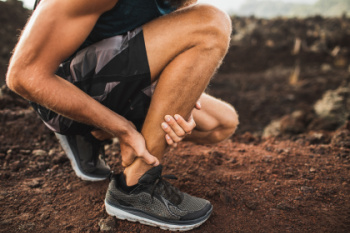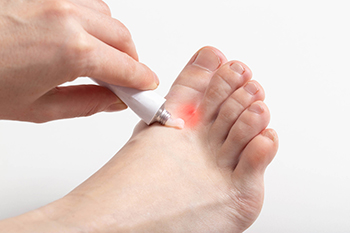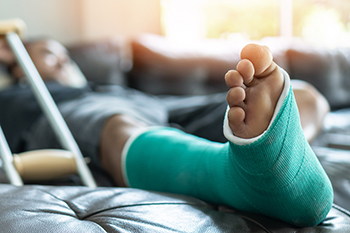March 2024
Causes and Treatment of Achilles Tendon Pain

Achilles tendon pain can arise from various causes and often affects the area where the Achilles tendon inserts into the back of the heel. The Achilles tendon is the largest tendon in the body, connecting the calf muscles to the heel bone, and facilitating activities like walking, running, and jumping. Common causes of Achilles tendon pain include overuse or repetitive strain, resulting in conditions such as Achilles tendinitis or tendinosis. These conditions involve inflammation or degeneration of the tendon due to excessive stress. Acute injuries such as Achilles tendon ruptures can occur from sudden, forceful movements, and are often accompanied by a popping sensation and severe pain. Treatment for Achilles tendon pain typically involves rest, compression, and elevation, in addition to medicine to help reduce pain and inflammation. Stretching exercises and custom-made orthotic devices may be recommended to improve flexibility and strength, which can help to support the Achilles tendon. In severe cases or ruptures, surgery may be necessary to repair the tendon. If you have a painful Achilles tendon, it is suggested that you schedule an appointment with a podiatrist for a proper diagnosis and treatment.
Achilles tendon injuries need immediate attention to avoid future complications. If you have any concerns, contact one of our doctors of Coral Desert Foot & Ankle. Our doctors can provide the care you need to keep you pain-free and on your feet.
What Is the Achilles Tendon?
The Achilles tendon is a tendon that connects the lower leg muscles and calf to the heel of the foot. It is the strongest tendon in the human body and is essential for making movement possible. Because this tendon is such an integral part of the body, any injuries to it can create immense difficulties and should immediately be presented to a doctor.
What Are the Symptoms of an Achilles Tendon Injury?
There are various types of injuries that can affect the Achilles tendon. The two most common injuries are Achilles tendinitis and ruptures of the tendon.
Achilles Tendinitis Symptoms
- Inflammation
- Dull to severe pain
- Increased blood flow to the tendon
- Thickening of the tendon
Rupture Symptoms
- Extreme pain and swelling in the foot
- Total immobility
Treatment and Prevention
Achilles tendon injuries are diagnosed by a thorough physical evaluation, which can include an MRI. Treatment involves rest, physical therapy, and in some cases, surgery. However, various preventative measures can be taken to avoid these injuries, such as:
- Thorough stretching of the tendon before and after exercise
- Strengthening exercises like calf raises, squats, leg curls, leg extensions, leg raises, lunges, and leg presses
If you have any questions please feel free to contact one of our offices located in St. George and Kanab, UT, and Mesquite, NV . We offer the newest diagnostic tools and technology to treat your foot and ankle needs.
Foot Protection for Cold Weather Work

As temperatures plummet, the need for foot protection becomes vital for those individuals working outdoors in winter. Working in cold weather poses unique challenges, especially for your extremities, which are susceptible to frostbite and injury if not properly shielded. Robust footwear emerges as the frontline defense against the elements. Thick, insulated boots crafted from durable materials, such as leather or synthetic fabrics, offer warmth and resilience against icy terrain. Ensuring a snug yet comfortable fit prevents chafing and discomfort during prolonged exposure to the cold. Additionally, layering socks proves instrumental in maintaining optimal foot temperature, with moisture-wicking fabrics serving to keep feet dry and insulated. Incorporating moisture-absorbing insoles also enhances both comfort and warmth, reducing the risk of frostbite and related ailments. If you are suffering from foot ailments brought on by working outdoors in winter, it is suggested that you make an appointment with a podiatrist for evaluation and treatment.
While working on the feet, it is important to take the proper care of them. For more information about working on your feet, contact one of our doctors from Coral Desert Foot & Ankle. Our doctors will treat your foot and ankle needs.
Working on Your Feet
Standing on your feet for long periods of time can cause stress and pain in your feet. Your whole body may experience change in terms of posture, back pain, bunions, callouses and or plantar warts. There are ways to avoid these conditions with proper foot care, smart choices and correct posture.
Positive Changes
Negative heeled shoe – Choosing this shoe type places the heel slightly lower than the ball of the foot. These are great for overall foot health. Find shoes that fit you correctly.
Go barefoot – Our feet were not designed to be enclosed for all hours of the day. Try to periodically expose your feet to air.
Eliminate Pain
Foot Exercises – Performing simple exercises, incorporating yoga and doing stretches are beneficial. This will allow increased blood flow to the area and muscles of the foot.
Achilles tendon – Stretching the foot out flat on the floor will relax the calf muscles and tendon. These exercises can be performed almost anywhere. Make sure you add these exercises to your daily regimen.
With a little bit of this information and knowing more about foot health, you will notice changes. Foot stretches and proper footwear will help with pain and prevent further issues.
If you have any questions please feel free to contact one of our offices located in St. George and Kanab, UT, and Mesquite, NV . We offer the newest diagnostic and treatment technologies for all your foot and ankle needs.
Causes of Athlete's Foot and Ways to Avoid It

Athlete's foot, a common fungal infection, can cause discomfort and itching, urging us to delve into its origins and effective prevention strategies. This condition thrives in warm, damp environments, making communal spaces like locker rooms, swimming pools, and shared showers breeding grounds. Direct contact with the fungus through contaminated surfaces or by sharing items such as towels and shoes facilitates its spread. Prevention begins with practicing good hygiene, including thorough drying between toes and keeping feet clean. Opting for breathable footwear and moisture-wicking socks helps maintain a dry environment, discouraging fungal growth. Regularly changing socks and allowing shoes to air out are essential habits to practice. Additionally, avoiding walking barefoot in public areas further reduces the risk of exposure. Swift attention to any signs of infection, such as redness or scaling, is pivotal for early intervention. If you have developed athlete’s foot, it is strongly suggested that you confer with a podiatrist who can effectively treat this condition, which may include prescribing medication.
Athlete’s foot is an inconvenient condition that can be easily reduced with the proper treatment. If you have any concerns about your feet and ankles, contact one of our doctors from Coral Desert Foot & Ankle. Our doctors will treat your foot and ankle needs.
Athlete’s Foot: The Sole Story
Athlete's foot, also known as tinea pedis, can be an extremely contagious foot infection. It is commonly contracted in public changing areas and bathrooms, dormitory style living quarters, around locker rooms and public swimming pools, or anywhere your feet often come into contact with other people.
Solutions to Combat Athlete’s Foot
- Hydrate your feet by using lotion
- Exfoliate
- Buff off nails
- Use of anti-fungal products
- Examine your feet and visit your doctor if any suspicious blisters or cuts develop
Athlete’s foot can cause many irritating symptoms such as dry and flaking skin, itching, and redness. Some more severe symptoms can include bleeding and cracked skin, intense itching and burning, and even pain when walking. In the worst cases, Athlete’s foot can cause blistering as well. Speak to your podiatrist for a better understanding of the different causes of Athlete’s foot, as well as help in determining which treatment options are best for you.
If you have any questions please feel free to contact one of our offices located in St. George and Kanab, UT, and Mesquite, NV . We offer the newest diagnostic and treatment technologies for all your foot and ankle needs.
Managing a Broken Foot

A broken foot, resulting from various causes such as sports injuries, falls, or accidents, can significantly impact your daily life. With 26 delicate bones in each foot, fractures are common and can lead to changes in physical appearance and movement. Symptoms of a broken foot include sudden or gradual pain, difficulty in bearing weight, swelling, bruising, altered gait pattern, and poor balance. Long-term treatment is needed for effective recovery. It typically involves the use of protective casts, boots, or supportive footwear to shield the foot during the healing process. The healing process for bones usually spans six to eight weeks, though the duration may extend based on the severity of your fracture. Beyond immediate care, rehabilitation exercises play an important role in restoring range of motion, mobility, strength, and balance. Because neglecting proper treatment can result in complications, it is imperative to prioritize comprehensive and sustained care for a broken foot. By adhering to these measures, individuals can optimize the healing process, minimize risks, and regain full functionality, ensuring a smoother road to recovery. If you have broken your foot, it is suggested that you schedule an appointment with a podiatrist as quickly as possible for an exam and appropriate treatment methods,
A broken foot requires immediate medical attention and treatment. If you need your feet checked, contact one of our doctors from Coral Desert Foot & Ankle. Our doctors can provide the care you need to keep you pain-free and on your feet.
Broken Foot Causes, Symptoms, and Treatment
A broken foot is caused by one of the bones in the foot typically breaking when bended, crushed, or stretched beyond its natural capabilities. Usually the location of the fracture indicates how the break occurred, whether it was through an object, fall, or any other type of injury.
Common Symptoms of Broken Feet:
- Bruising
- Pain
- Redness
- Swelling
- Blue in color
- Numbness
- Cold
- Misshapen
- Cuts
- Deformities
Those that suspect they have a broken foot shoot seek urgent medical attention where a medical professional could diagnose the severity.
Treatment for broken bones varies depending on the cause, severity and location. Some will require the use of splints, casts or crutches while others could even involve surgery to repair the broken bones. Personal care includes the use of ice and keeping the foot stabilized and elevated.
If you have any questions please feel free to contact one of our offices located in St. George and Kanab, UT, and Mesquite, NV . We offer the newest diagnostic and treatment technologies for all your foot and ankle needs.





